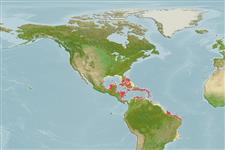Preferred temperature (Ref.
123201): 26.4 - 28.2, mean 27.5 °C (based on 570 cells).
Phylogenetic diversity index (Ref.
82804): PD
50 = 0.7500 [Uniqueness, from 0.5 = low to 2.0 = high].
Bayesian length-weight: a=0.00617 (0.00250 - 0.01521), b=3.15 (2.94 - 3.36), in cm total length, based on LWR estimates for this (Sub)family-body shape (Ref.
93245).
Nivel trófico (Ref.
69278): 3.3 ±0.46 se; based on food items.
Generation time: 0.5 ( na - na) years. Estimated as median ln(3)/K based on 1
growth studies.
Resiliencia (Ref.
120179): Alto, población duplicada en un tiempo mínimo inferior a 15 meses (K=2.42; tmax=1; assuming tm<1;).
Fishing Vulnerability (Ref.
59153): Low vulnerability (10 of 100).
Nutrients (Ref.
124155): Calcium = 391 [177, 1,089] mg/100g; Iron = 1.68 [0.74, 3.44] mg/100g; Protein = 17.3 [15.8, 18.8] %; Omega3 = 0.147 [0.059, 0.398] g/100g; Selenium = 40.6 [12.4, 124.3] μg/100g; VitaminA = 126 [27, 550] μg/100g; Zinc = 4.15 [2.27, 6.82] mg/100g (wet weight);
